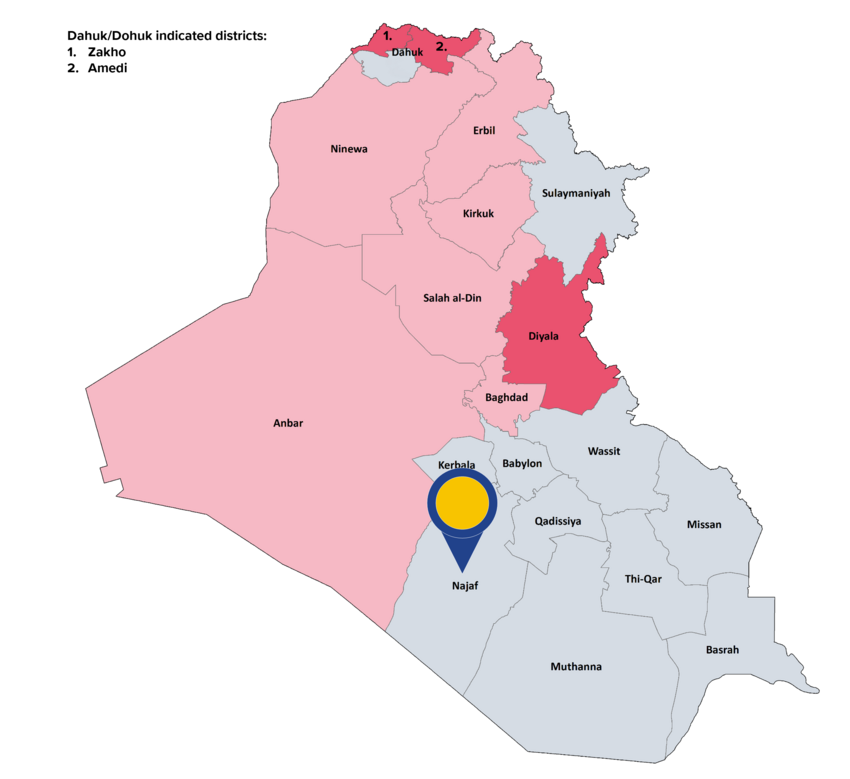COMMON ANALYSIS
Last update: June 2022
General information
Najaf governorate is located in the southwestern part of Iraq. It borders the governorates of Anbar, Babil, Qadissiya and Muthanna governorates, and shares an international border with Saudi Arabia to the south. The governorate is divided into three districts: Al-Najaf, Al-Kufah and Al-Manathera. The capital of the governorate is Najaf City. The Iraqi CSO estimated the governorate’s population for 2021 at 1 589 961, with the majority being Shia Arab.
Background of the conflict
Following the 2003 invasion, Najaf became a stronghold for the influential Shia cleric Muqtada Al-Sadr and the Jaysh Al-Mahdi (JAM) militia, which he founded in 2003 to fight the US-led coalition forces. JAM was disbanded in 2008, however, a small armed branch, the Promised Day Brigade, remained active. In 2014, Muqtada Al-Sadr formed another militia group, Saraya Al-Salam (Peace Brigades or Peace Companies), to fight the advance of ISIL, but also to protect Shia shrines and religious sites. The group was involved in fatal clashes with protesters in February 2020, where 23 protesters were killed and 182 injured when members of the militia group attacked a protest camp. While at first both the religious authority of Najaf and Muqtada Al-Sadr supported the demands of the protest movement, the latter withdrew his support in January 2020. According to some reports this decision was connected to the nomination of Mohammed Allawi as new prime minister, others attributed it to internal power-struggles.
Anti-government protests in Najaf were reported in 2020 and 2021. In some cases, protesters set up roadblocks or blocked roads with burning tires. Several people were injured during protests against the local government. Moreover, activists reported of attacks and threats by militias.
Actors: control and presence
In February 2020, Iraqi Armed Forces handed over to the police forces of Najaf all security duties for the governorate. As of March 2021, ISF in Najaf governorate included the Middle Euphrates Operation Command (MEOC), commandos brigade and emergency regiments as well as local and federal police.
Presence of PMF was also reported. In September 2021, four militia groups associated with Grand Ayatollah Ali Al-Sistani and the religious authority (Marja’iya) of Najaf, announced the formation of an armed unit, the Holy Shrine Unit (Hashd Al-Atabat), separate from the PMF organisation and under the Iraqi army.
In February 2020, there were reports on attempts by ISIL to establish a presence in the region.
Nature of violence and examples of incidents
Between August 2020 and July 2021, at least three IED attacks and three attacks with grenades by unidentified perpetrators on civilians were reported. Other attacks in the reference period included a bomb attack on a language school and assaults with Molotov cocktails on a party office and on the house of a former affiliate of Muqtada Al-Sadr.
Antigovernmental protests were recorded in Najaf during the reference period. A party office was set on fire during protests in reaction to the killing of activist Ihab Al-Wazni in neighbouring Karbala governorate.
Incidents: data
In the reference period, ACLED reported a total of 21 security incidents (average of 0.3 security incidents per week) in Najaf of which 10 incidents were coded as explosions/remote violence, 7 as incidents of violence against civilians and 4 as battles. UNAMI[38] recorded no armed conflict-related incidents in the period from 1 August to 31 December 2020 and 1 armed conflict related incident in the period from 1 January to 31 October 2021.
Geographical scope
While the three Najaf’s districts were affected by security incidents, the majority of them were recorded in Al-Najaf district.
Civilian casualties: data
In the reference period, UNAMI recorded a total of 4 civilian casualties (1 deaths and 3 injured) in the aforementioned armed conflict-related incident. More specifically, they all occurred from 1st January until 31 October 2021.
Displacement
As of 30 September 2021, Najaf governorate hosted a total number of 9 078 IDPs, the vast majority of them originating from Ninewa (99 %). The majority of the IDPs had come to the governorate in the period June to August 2014. 97 % of IDPs in Najaf governorate were Shia and Sunni Turkmens. No IDPs from Najaf governorate were documented in other parts of the country and no returns to Najaf governorate were recorded.
Further impact on civilians
As of August 2020, the area contaminated by ERW in the governorate was listed at 663 032 square meters. At least three people died in accidents involving war remnants in 2021.
|
|
Looking at the indicators, it can be concluded that in the governorate of Najaf there is, in general, no real risk for a civilian to be personally affected within the meaning of Article 15(c) QD. |
Main COI references: Security 2022, 2.15

[38] UNAMI data focuses on armed conflict-related incidents, which have directly impacted civilians (causing civilian casualties) and the civilian nature of property and protected areas (such as civilian houses, cropland, schools, health facilities and mosque), see ‘Indicators of indiscriminate violence, number of incidents’.
